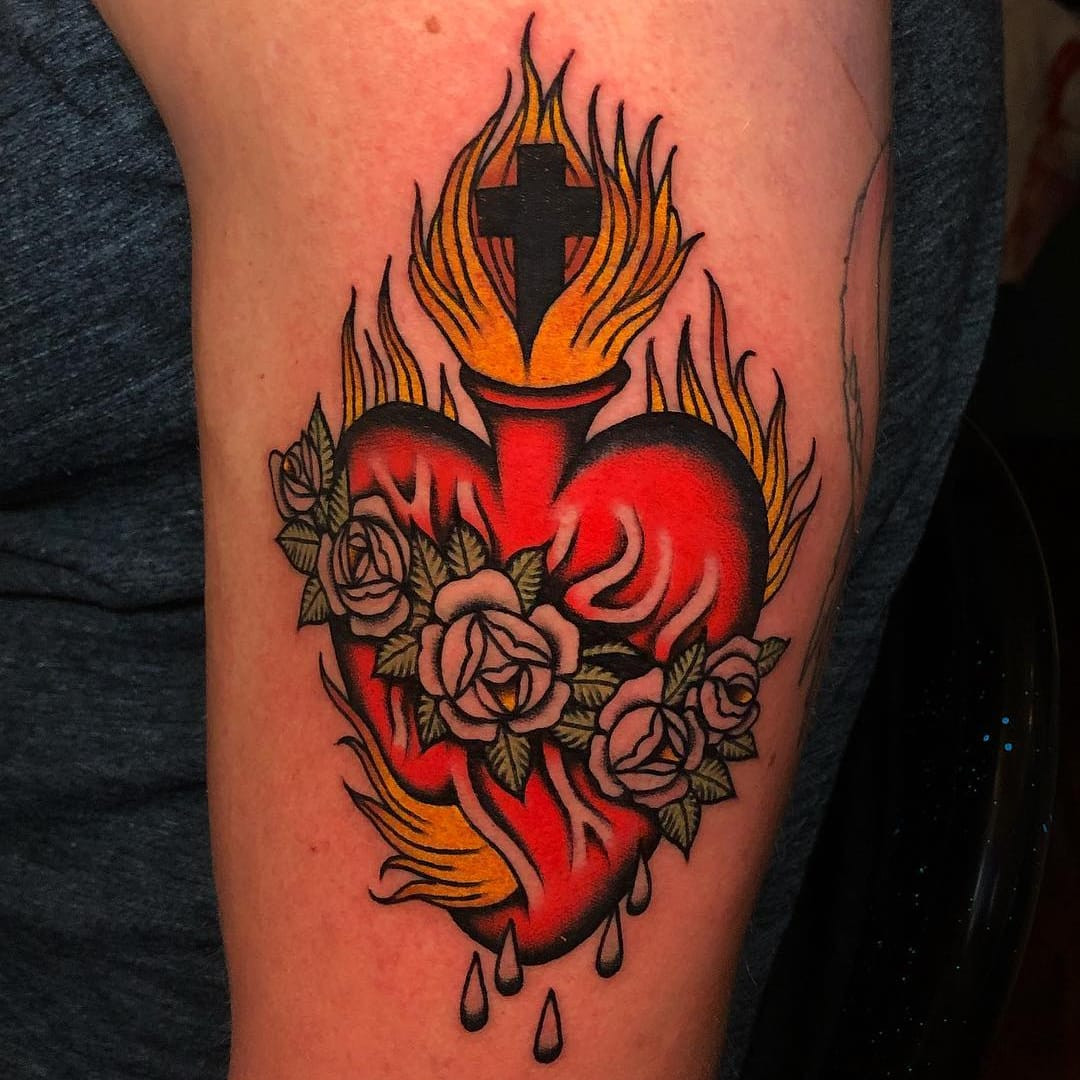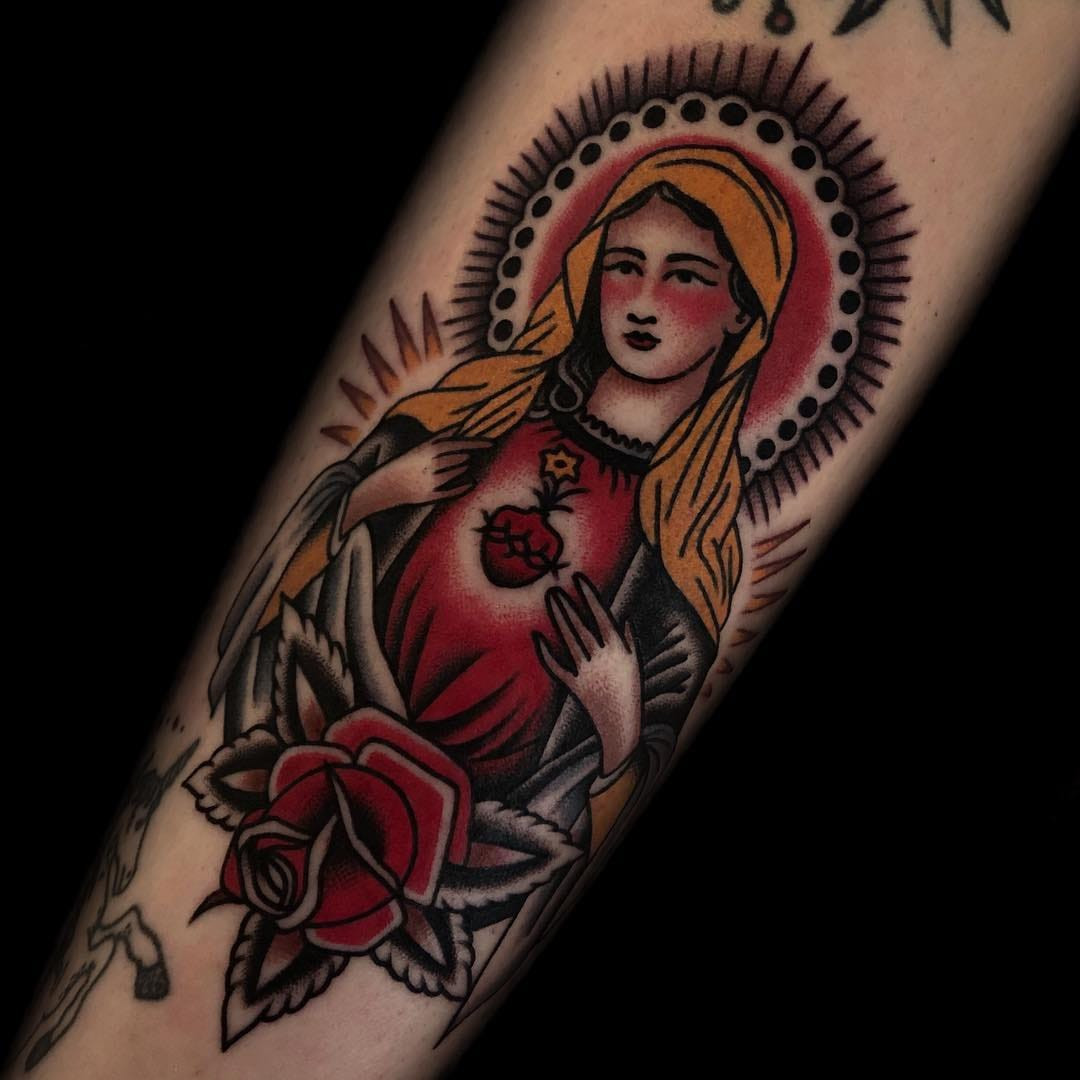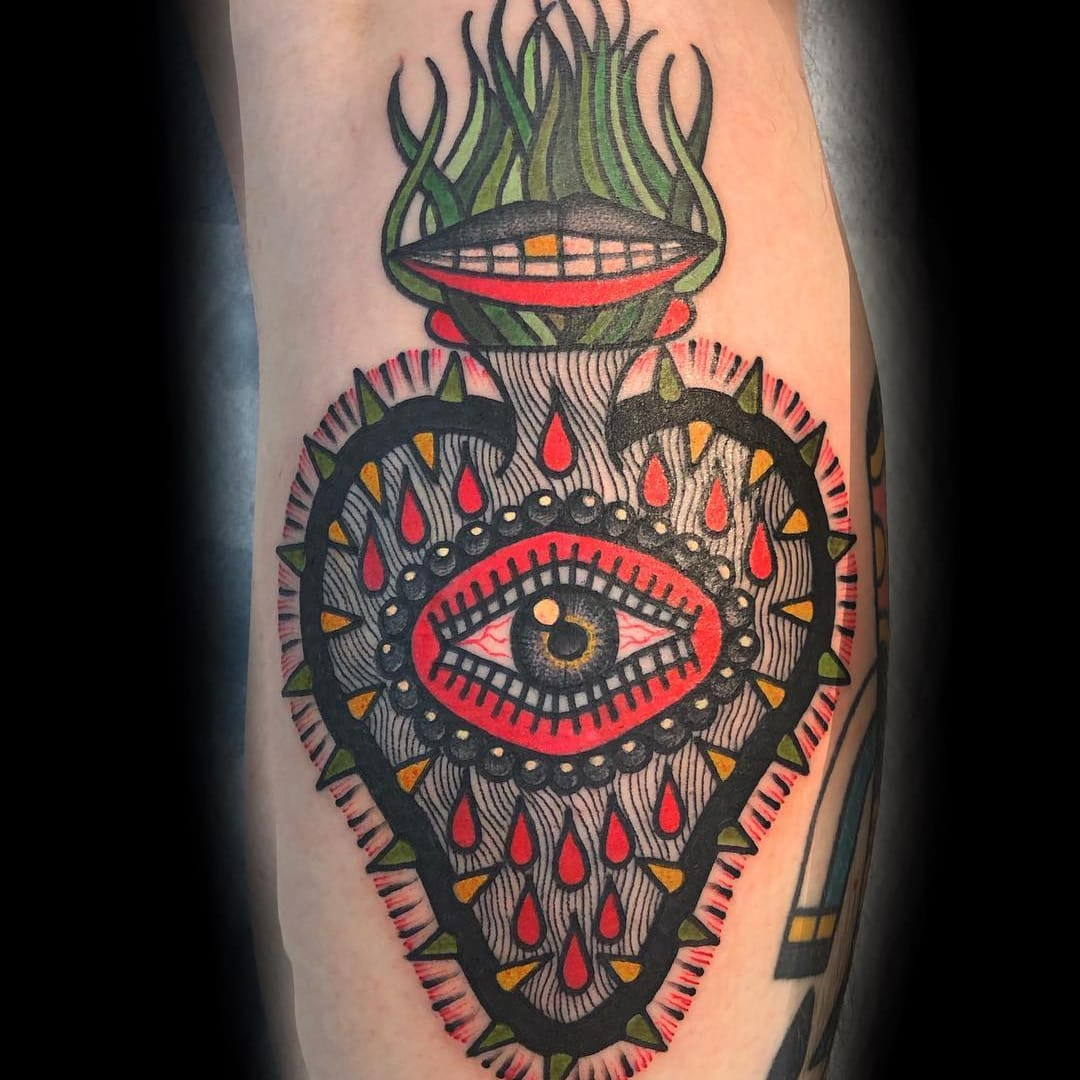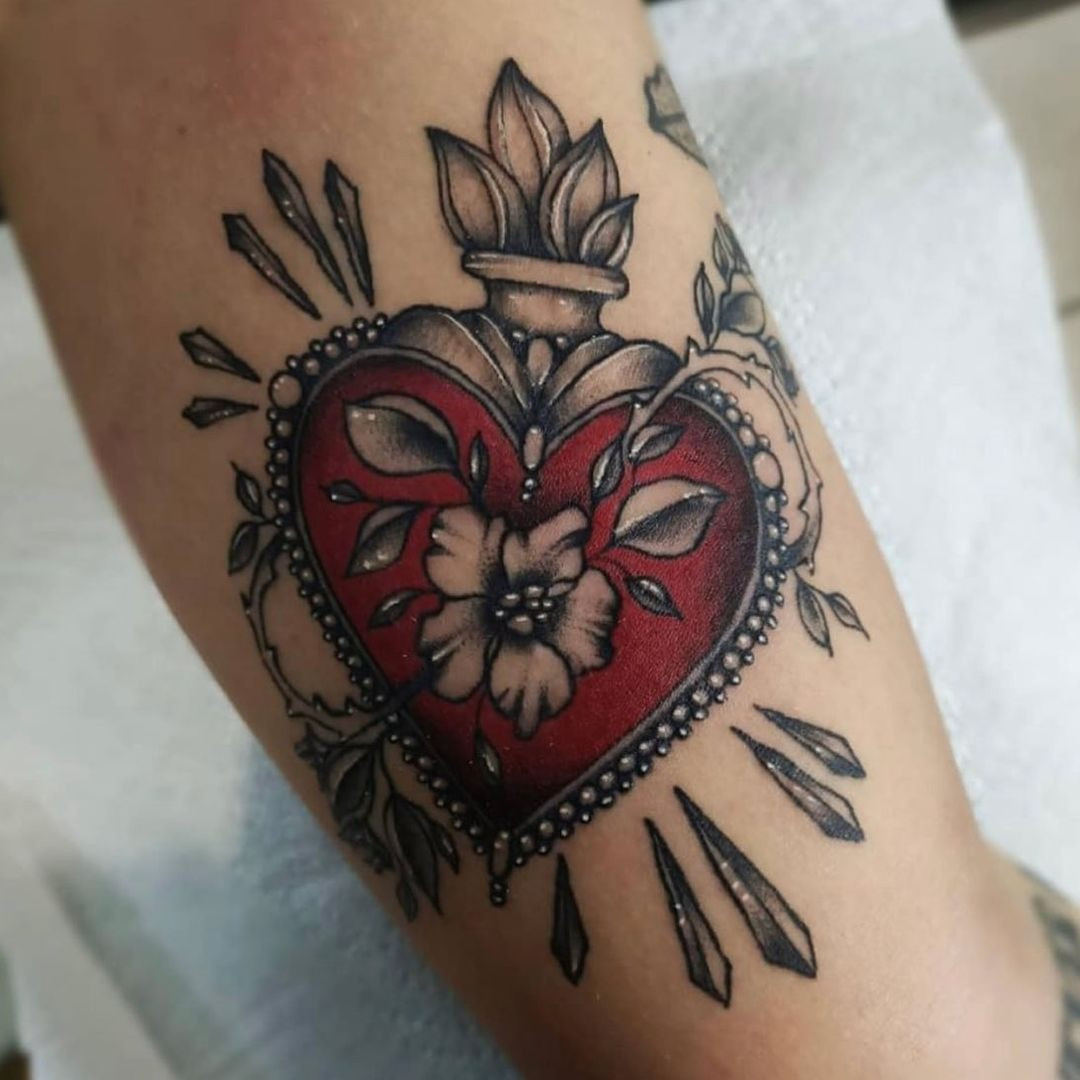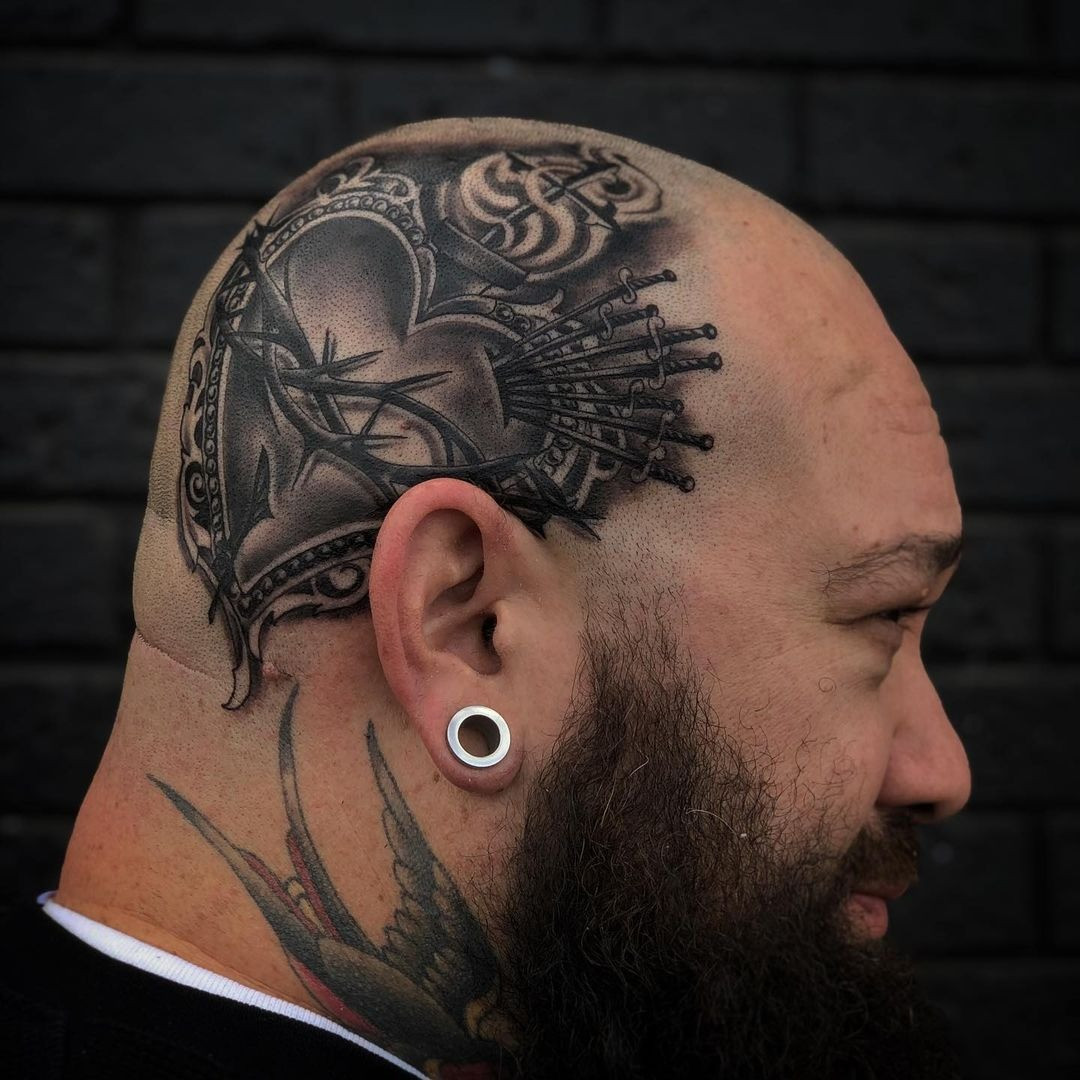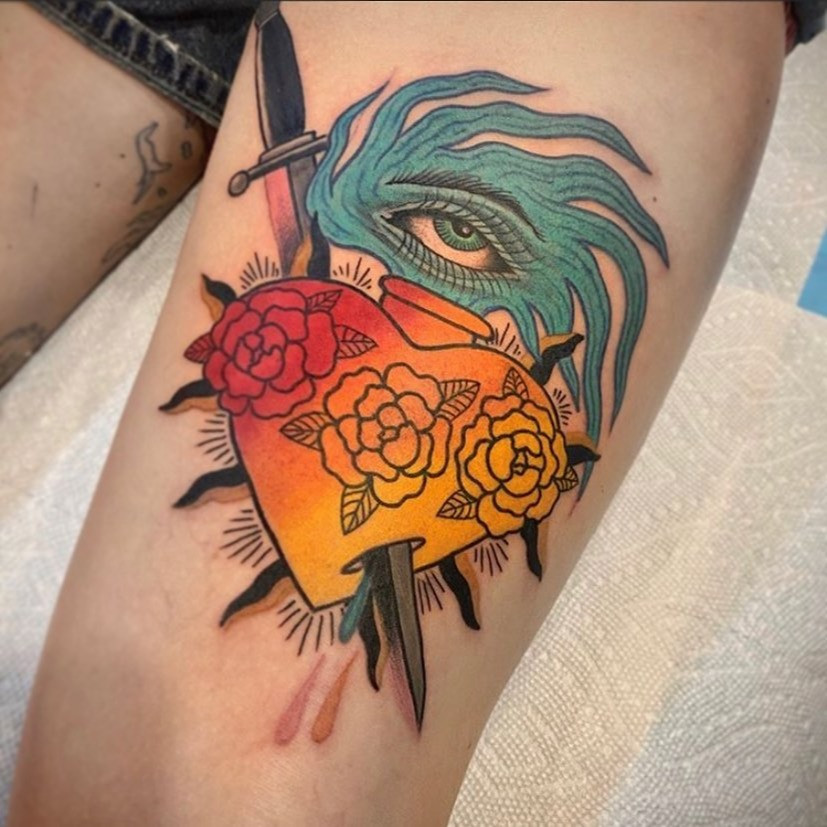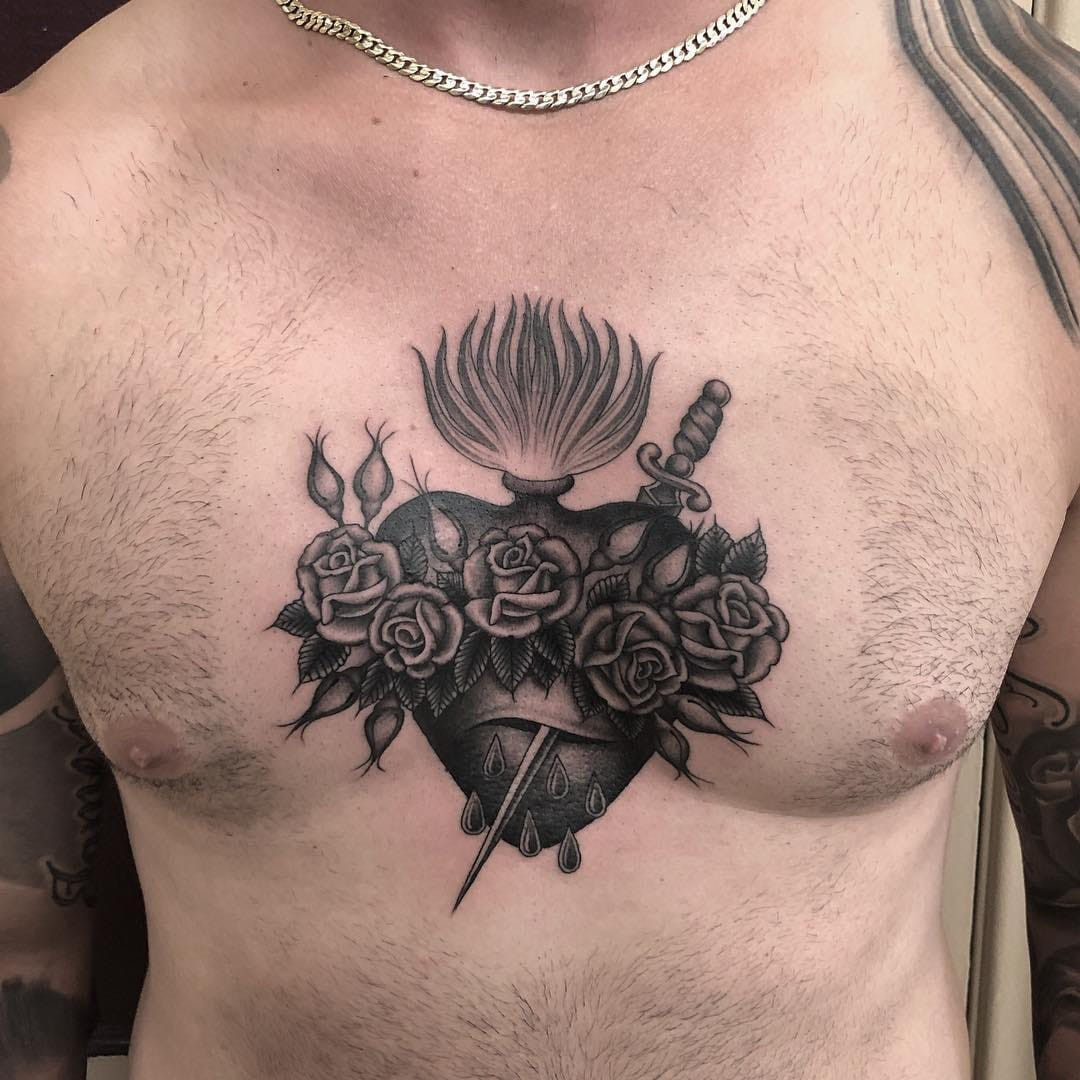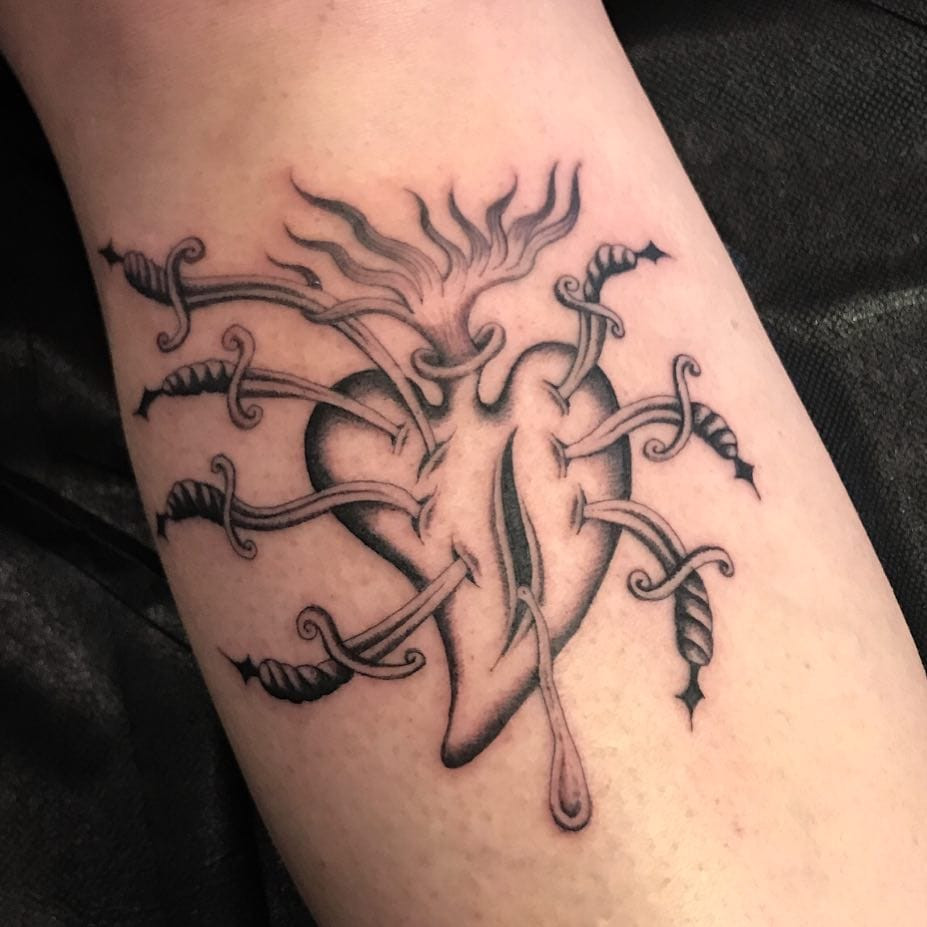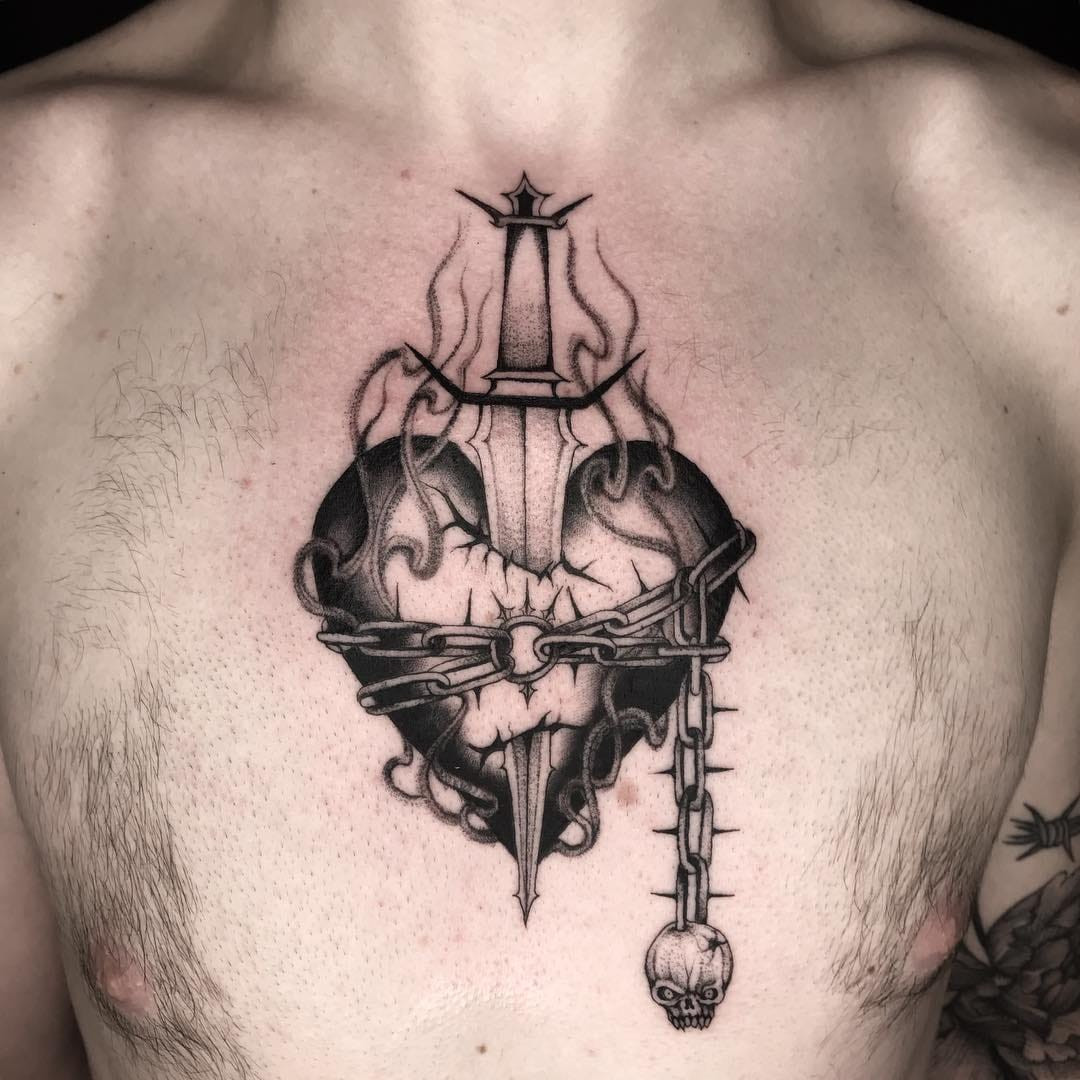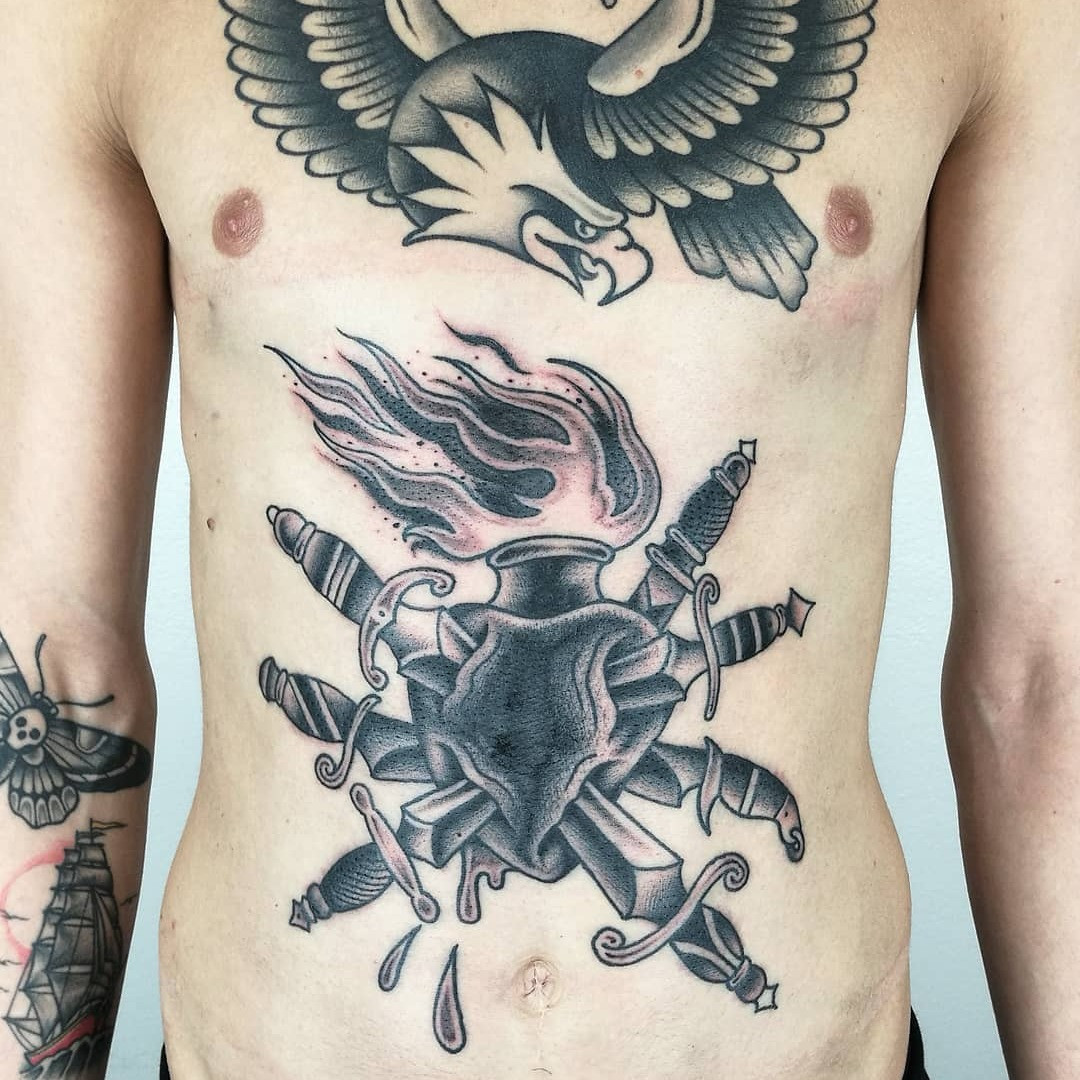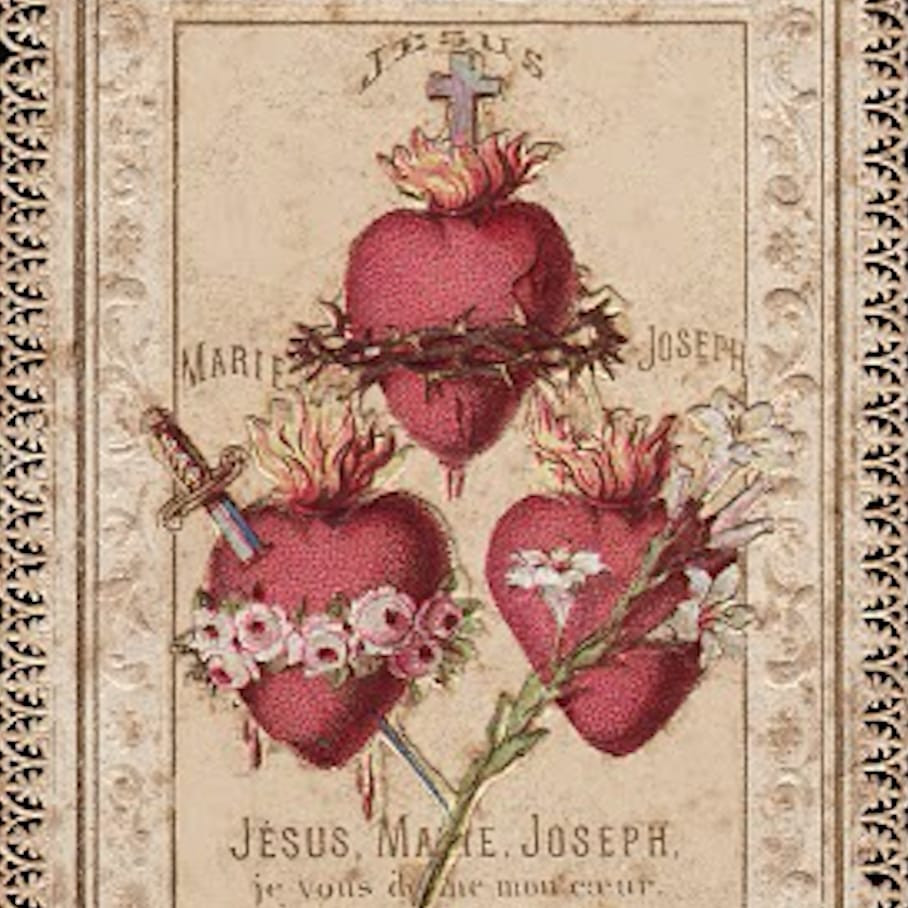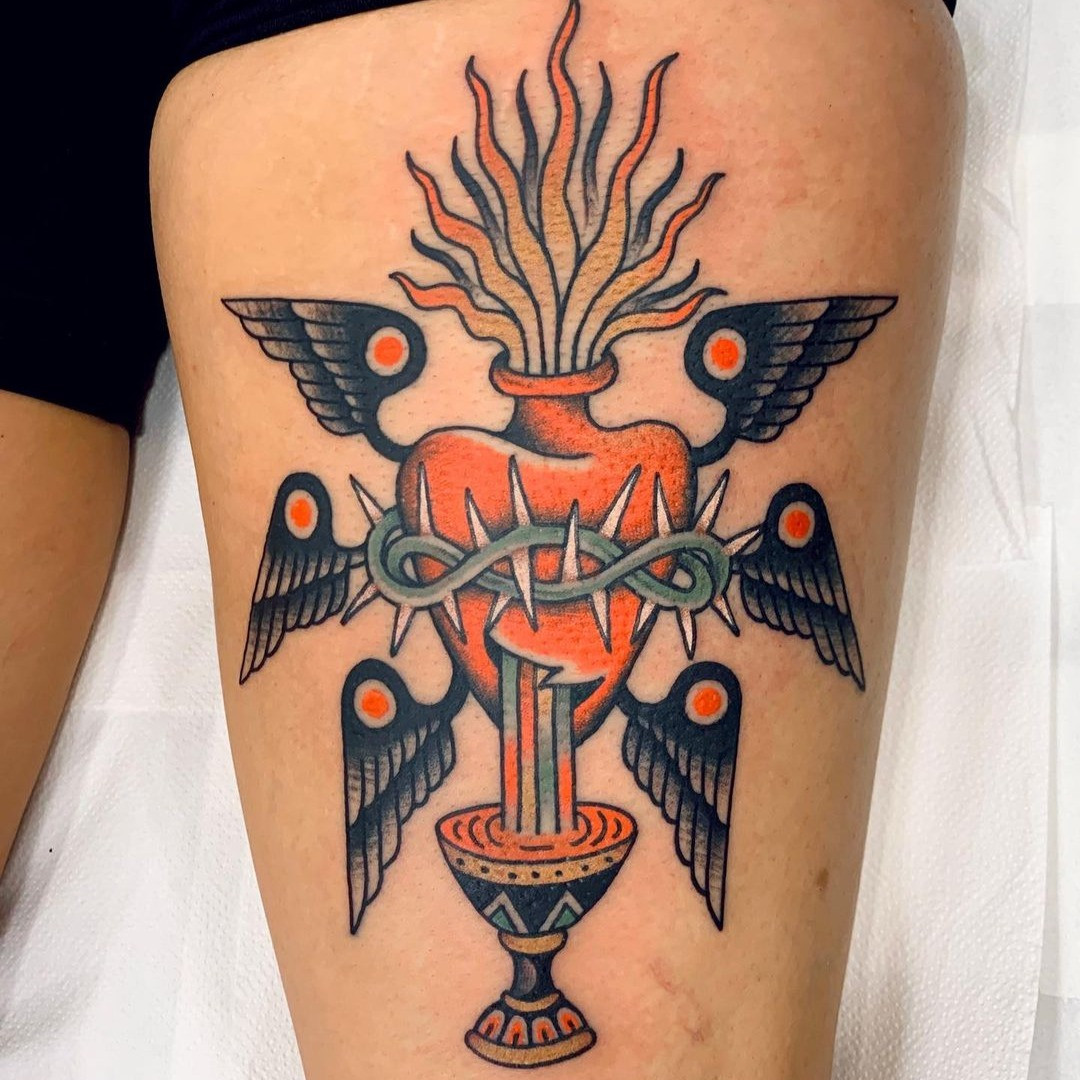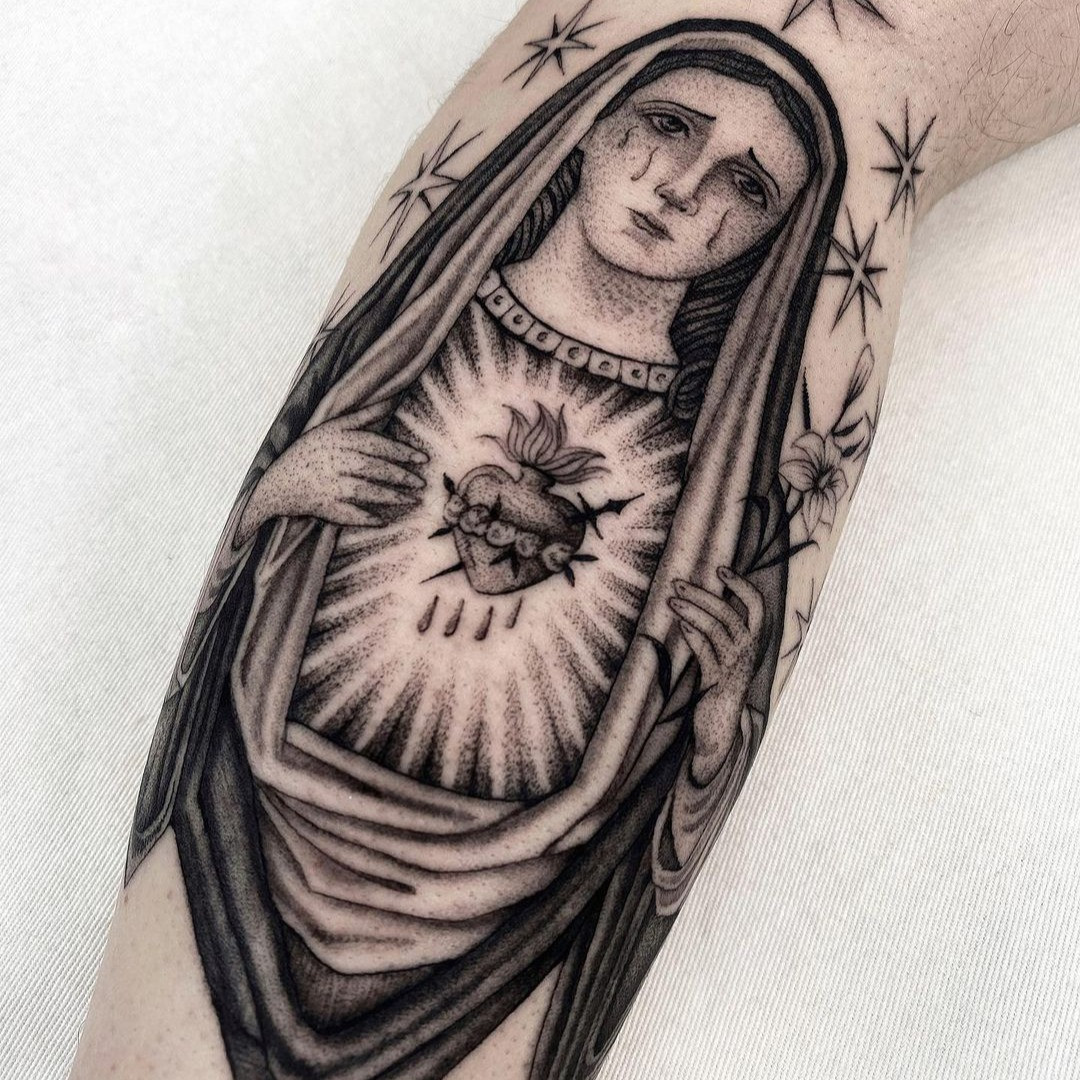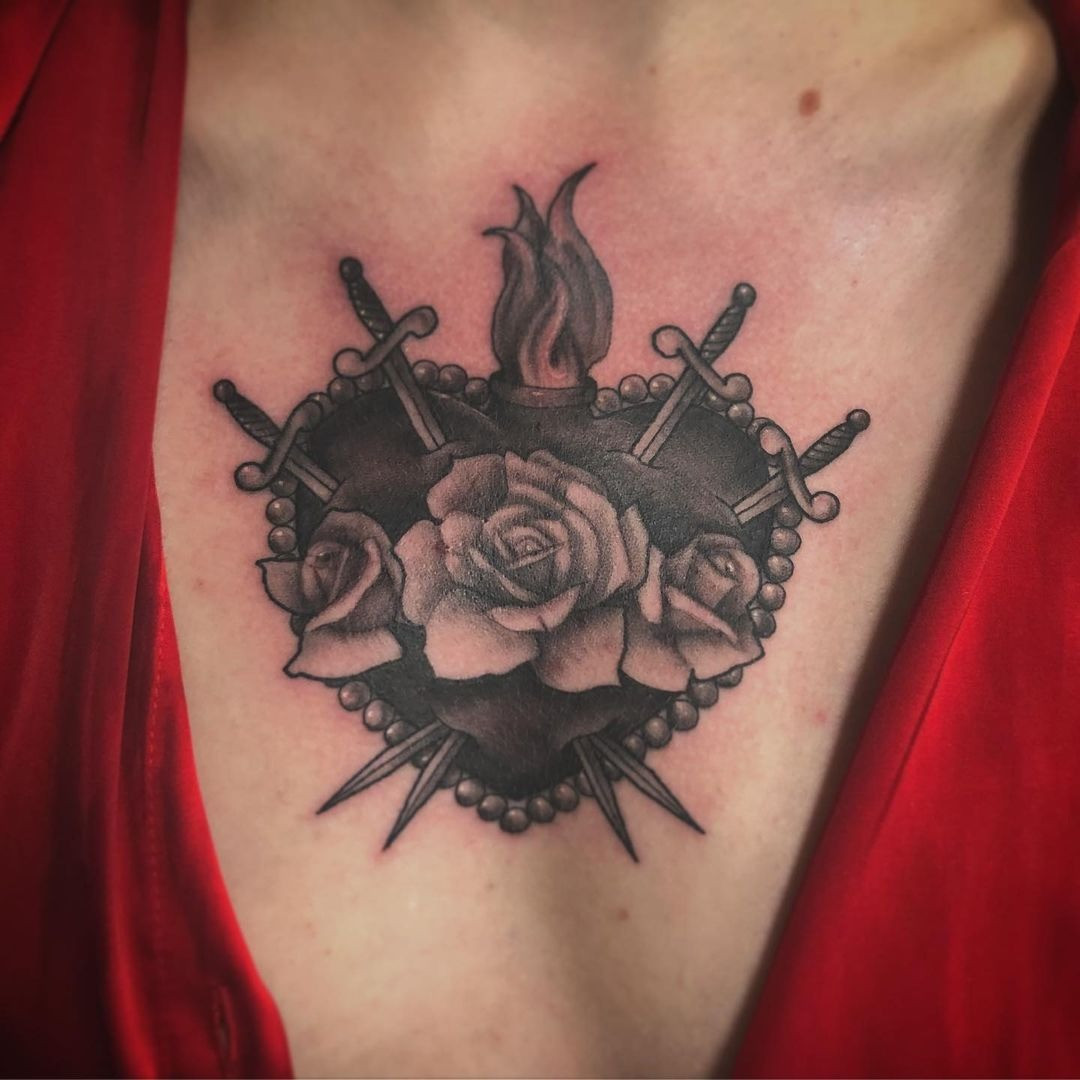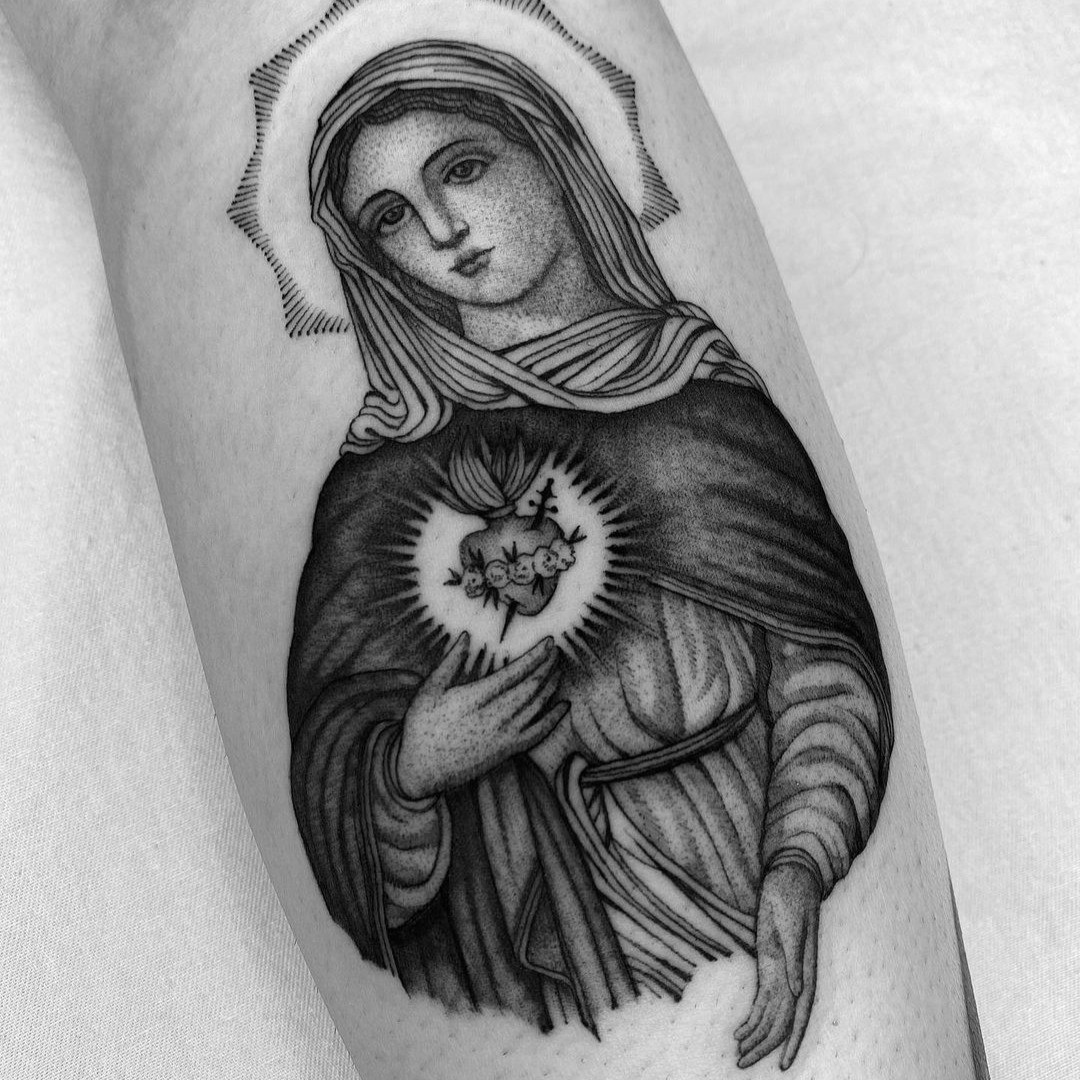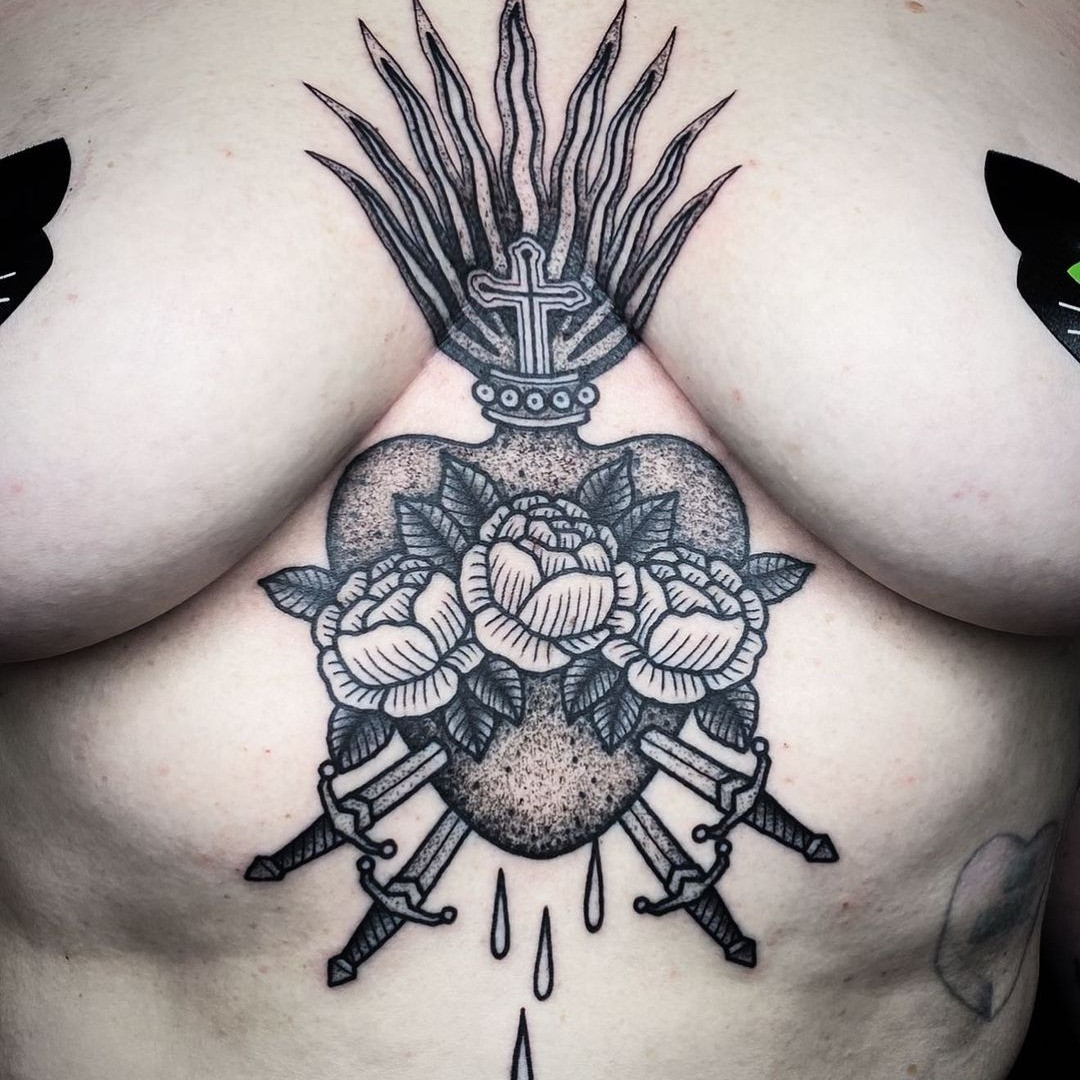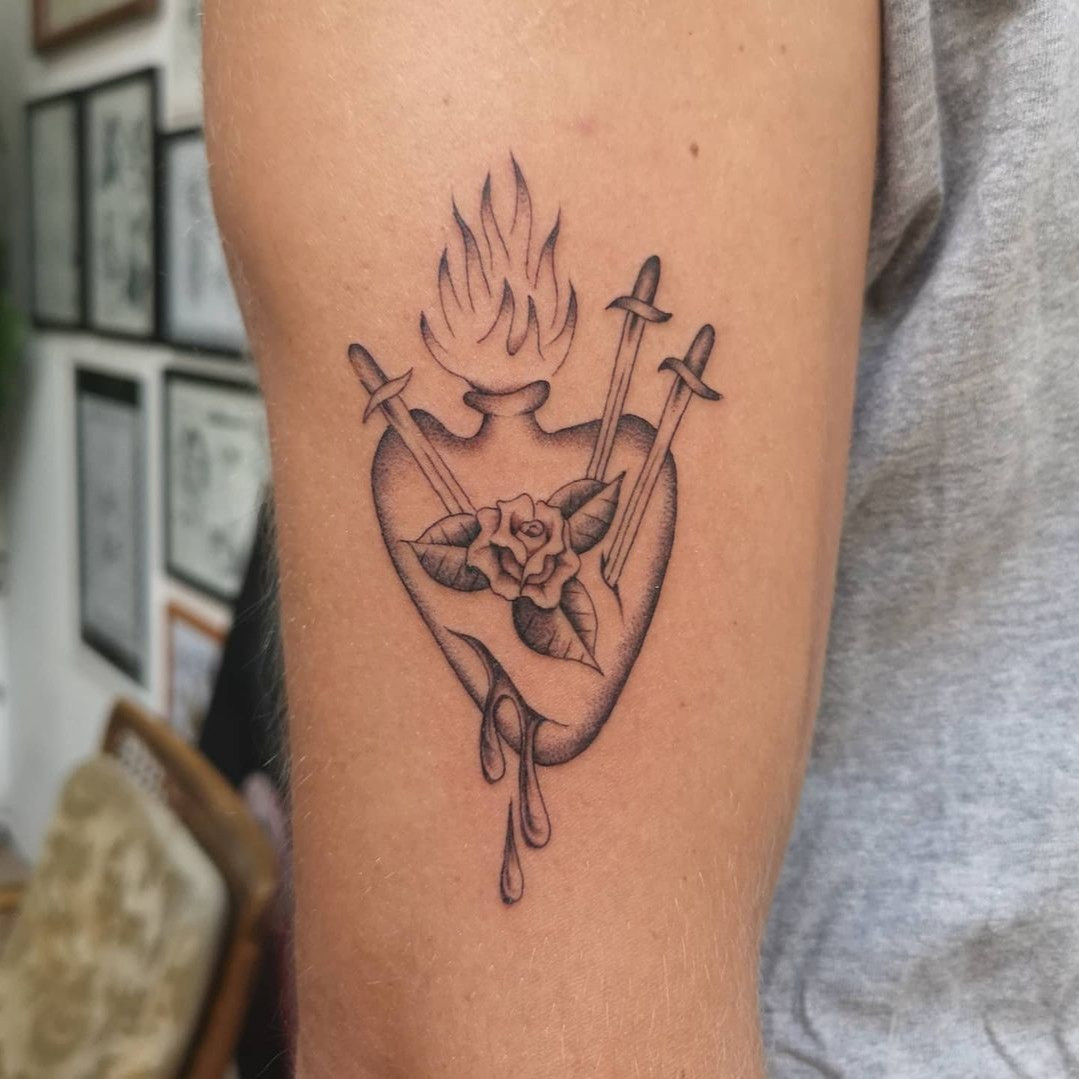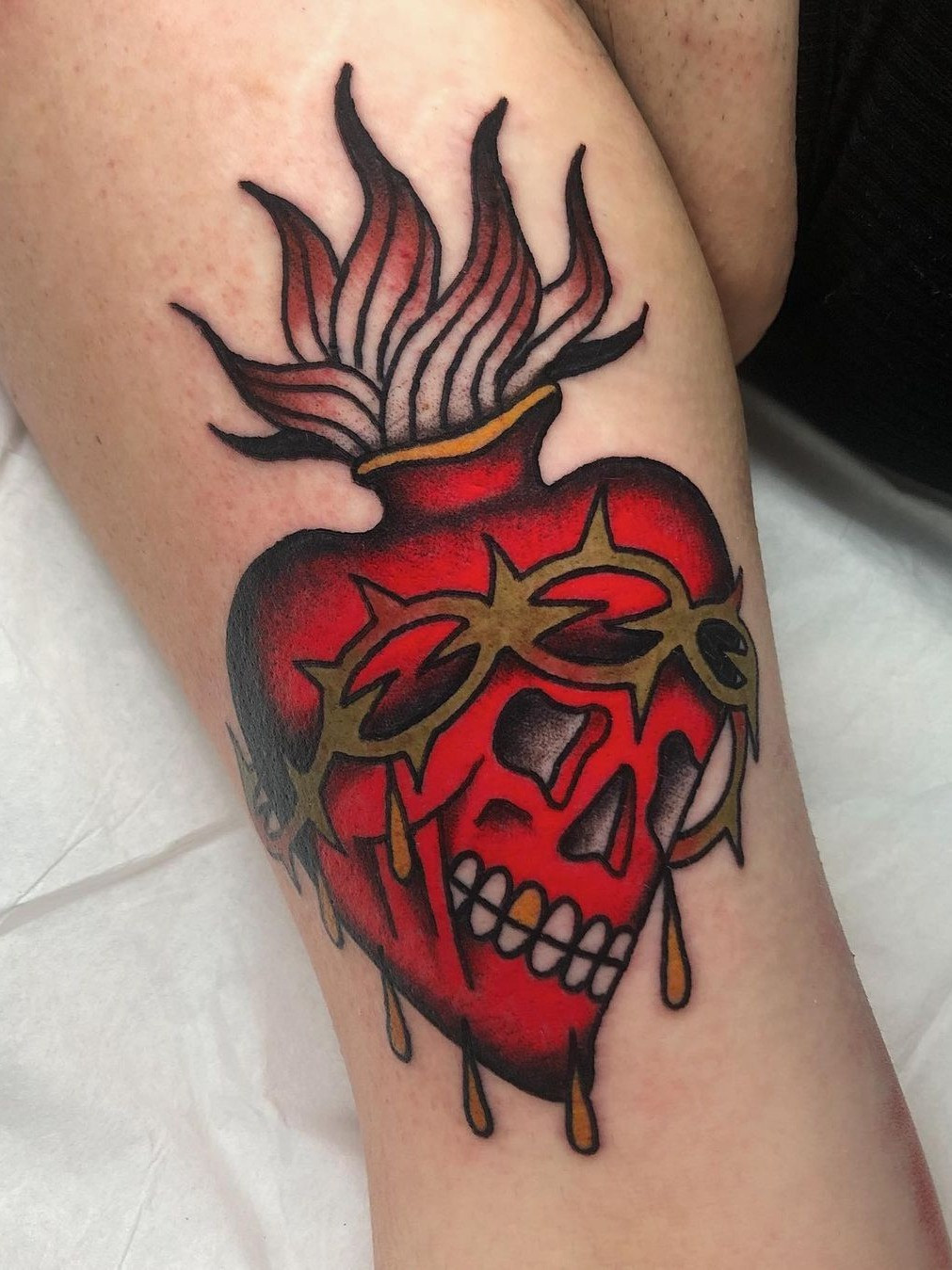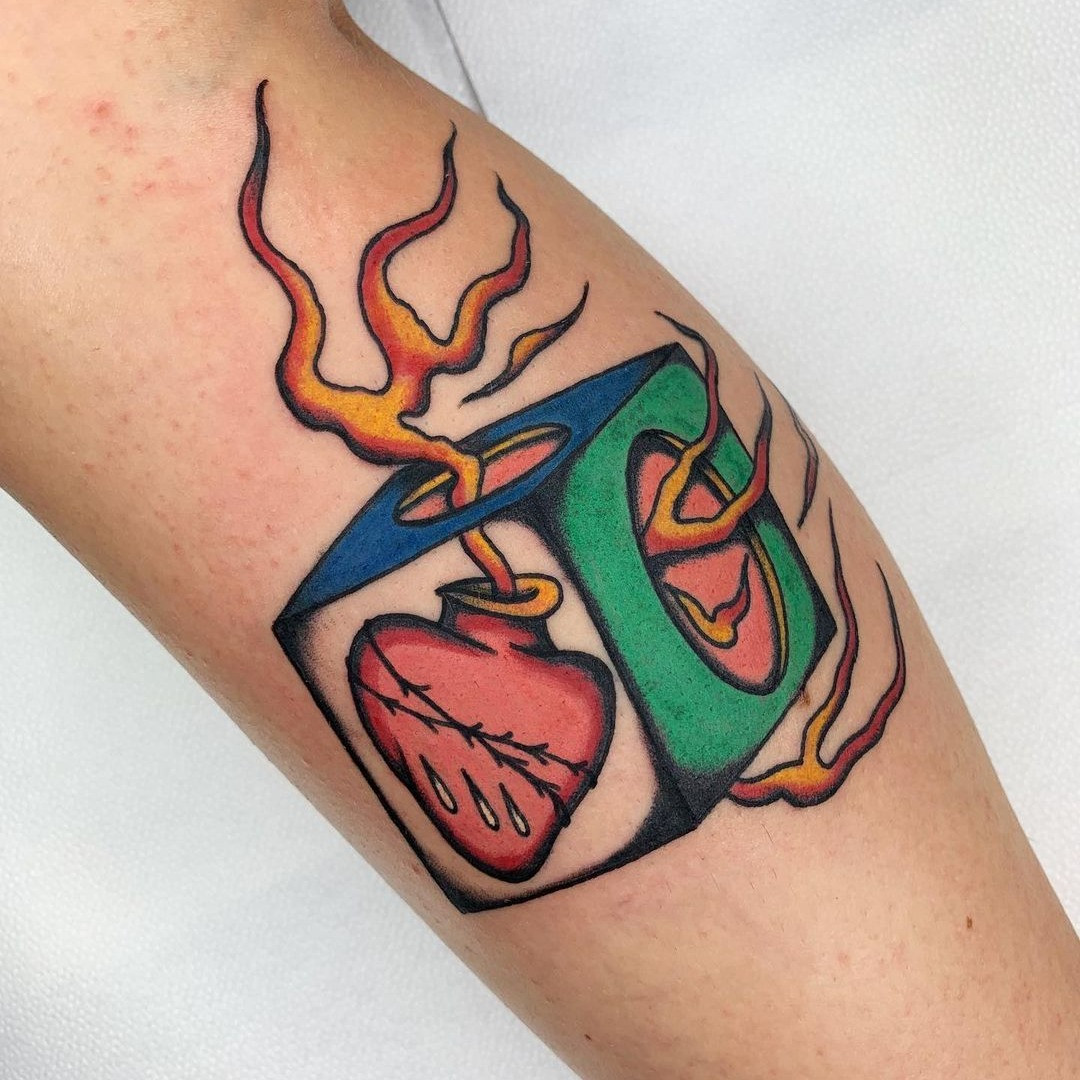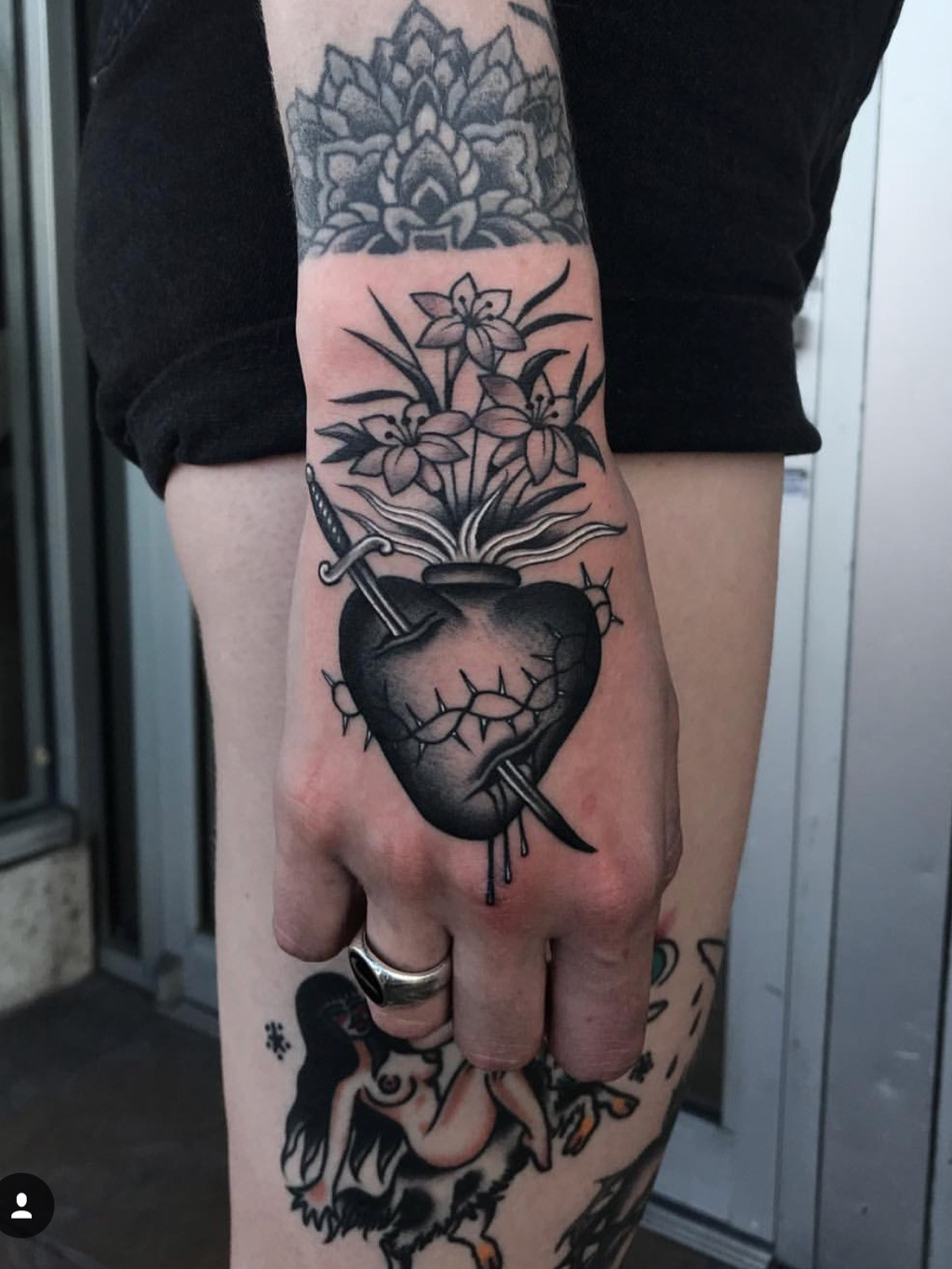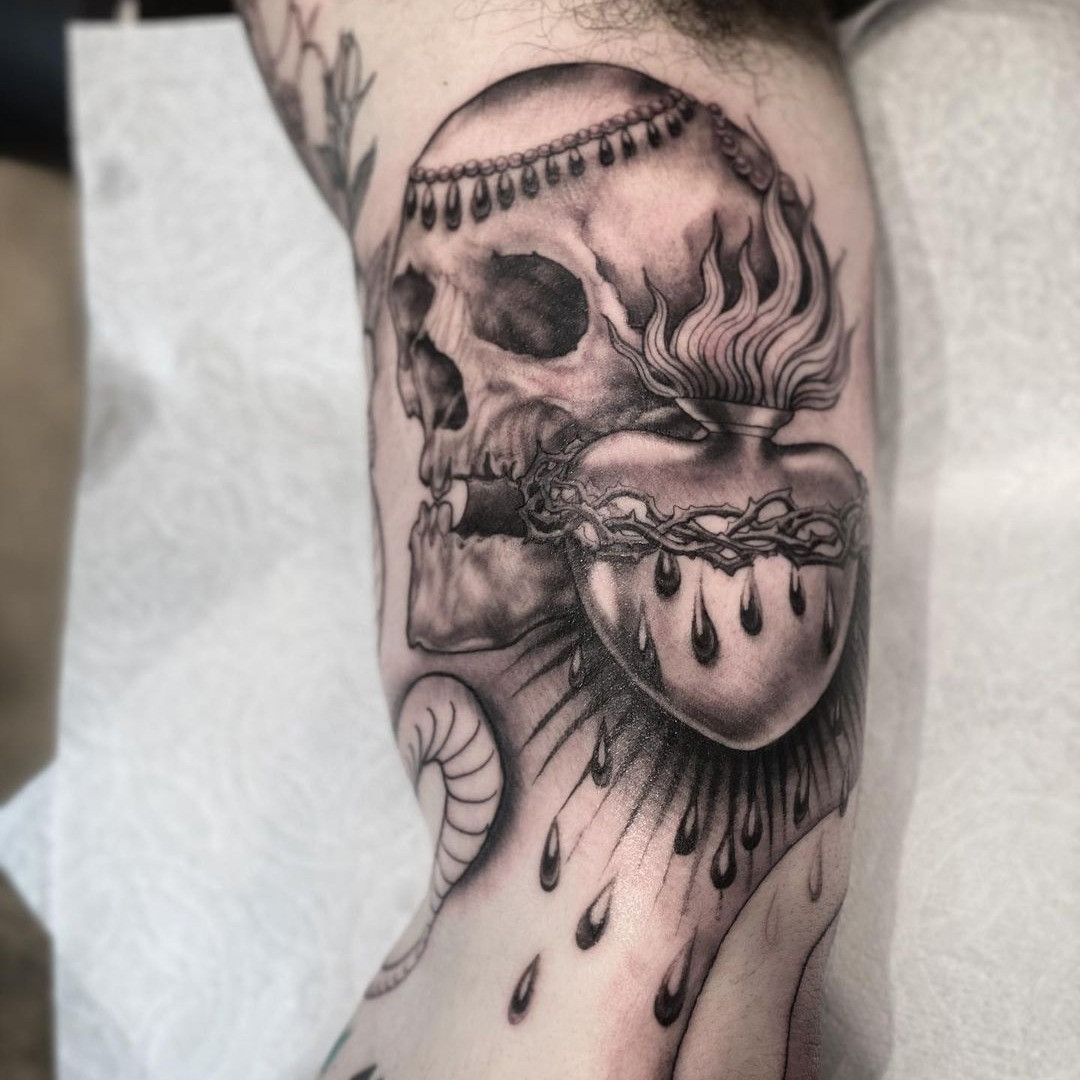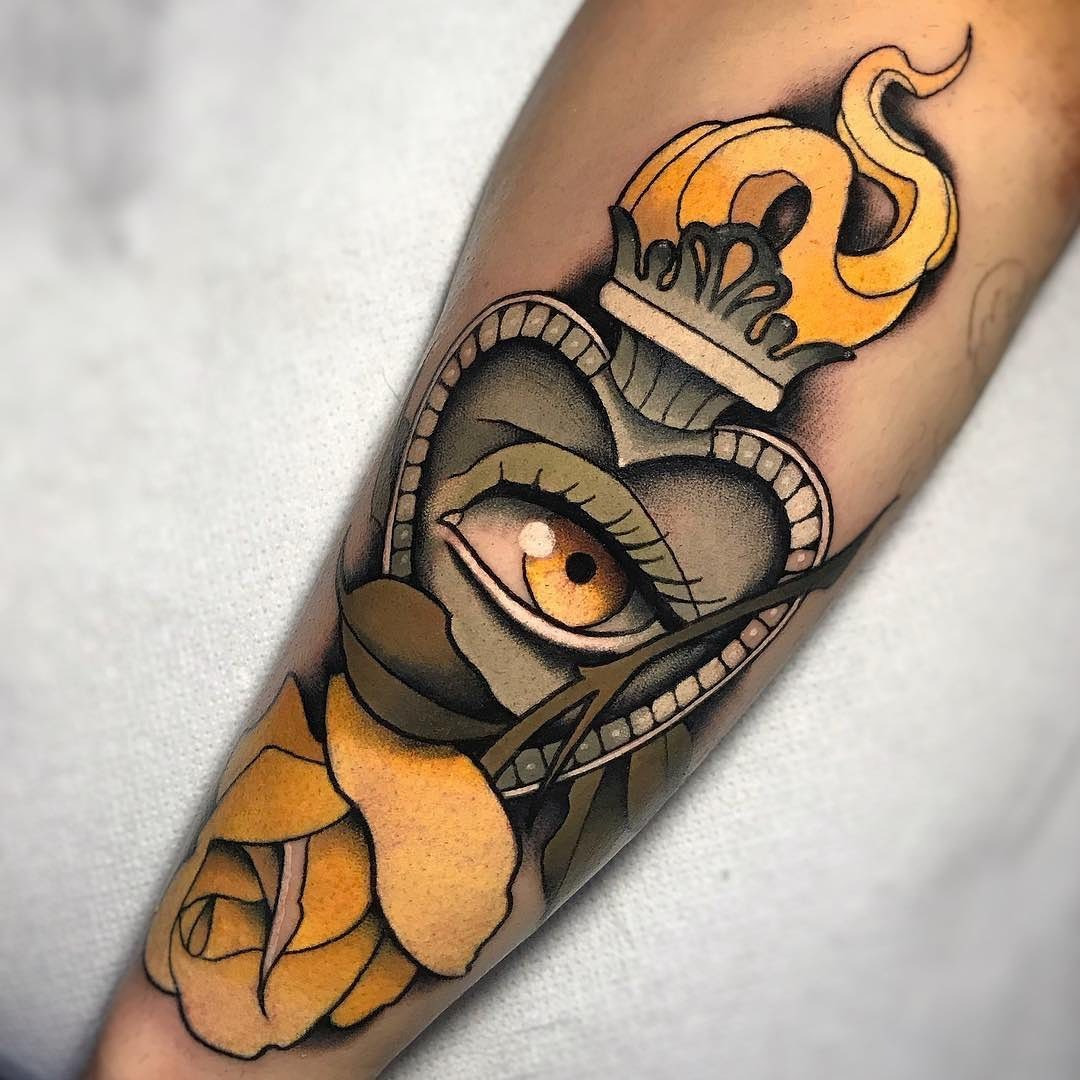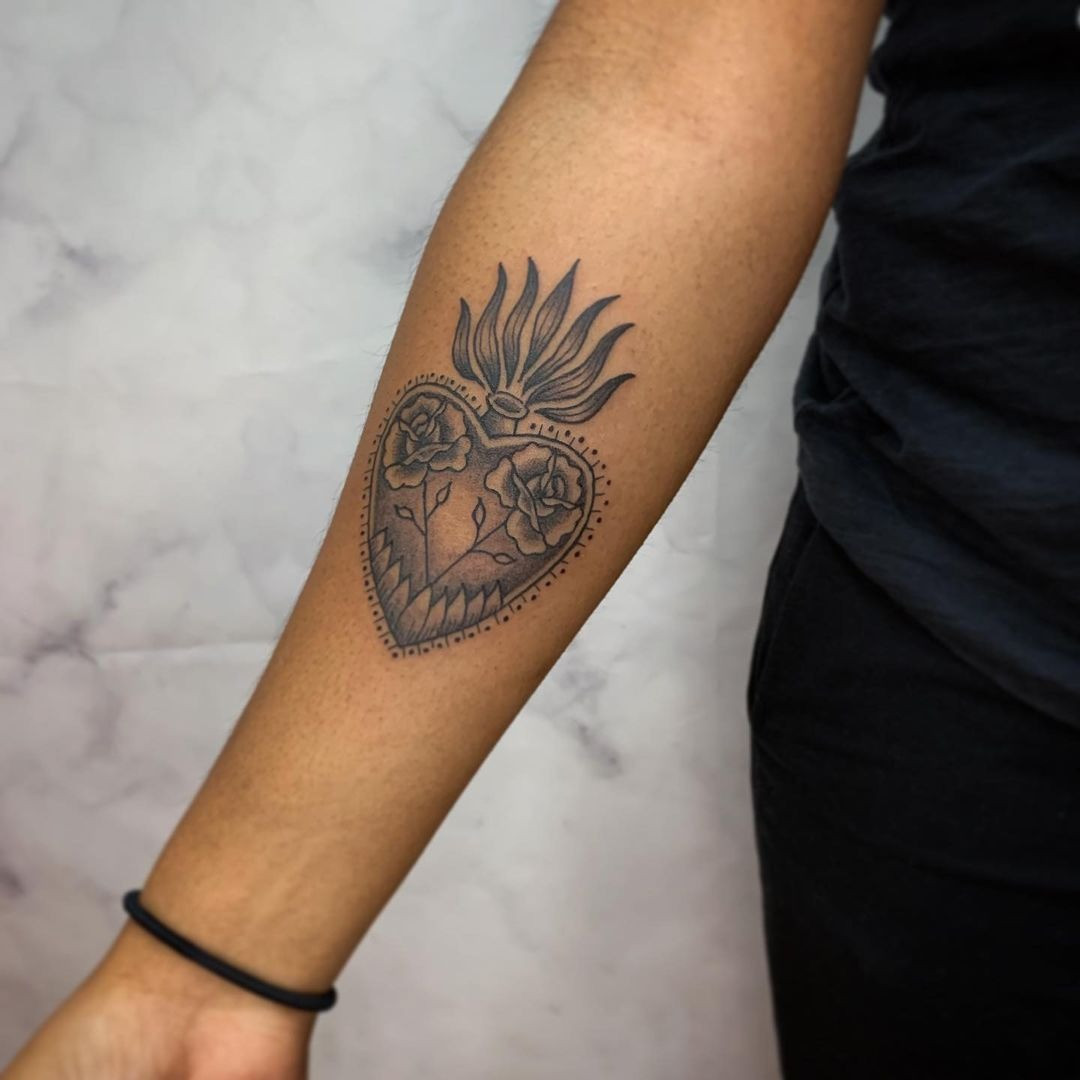Sacred heart tattoos stand as powerful and instantly recognizable symbols within the world of body art. Rooted deeply in Christian iconography, particularly within the Catholic tradition, the sacred heart transcends mere aesthetics, carrying profound meanings of faith, love, sacrifice, and devotion. For those seeking a tattoo that is rich in symbolism and visually striking, the Traditional Sacred Heart Tattoo offers a timeless and compelling choice.
The imagery of the sacred heart, with its flaming, often bleeding heart encircled by thorns, resonates across cultures and generations. Its enduring popularity is not just due to its striking visual elements, but also to the depth of meaning imbued in each component of the design. Understanding the symbolism and history behind the traditional sacred heart tattoo can greatly enhance its personal significance for the wearer.
Unpacking the Meaning of a Sacred Heart Tattoo
While the interpretation of any tattoo is ultimately personal, the sacred heart tattoo carries a widely understood core meaning, especially within its traditional context. For many, adorning themselves with a sacred heart tattoo is a powerful declaration of their Christian or Catholic faith. It serves as a constant reminder of Christ’s boundless love for humanity and his ultimate sacrifice.
The traditional elements within the sacred heart design are laden with symbolism:
- The Heart: Represents the physical heart of Jesus Christ, but more importantly, symbolizes his divine love, compassion, and emotions. It is the core of his being and his unwavering affection for humankind.
- The Flames: Emanating from the heart, the flames are a potent symbol of transformative love and fervent passion. They represent the burning intensity of Christ’s love and his zeal for humanity. In a broader sense, fire can also symbolize purification and spiritual energy.
- The Thorns: The crown of thorns encircling the heart is a direct reference to the suffering and pain endured by Jesus during his crucifixion. It represents his earthly trials, his sacrifice for humanity’s sins, and the pain inherent in love and devotion.
- Blood: Often depicted dripping from the heart, blood symbolizes Christ’s sacrifice and the shedding of his blood for the salvation of humanity. It’s a powerful reminder of the cost of love and redemption.
- Light or Radiance: Sometimes depicted as rays of light emanating from the heart, this element signifies divine grace, holiness, and the illuminating power of Christ’s love.
Beyond representing Jesus, sacred heart tattoos can also be adapted to honor Mary, the mother of Jesus. The Immaculate Heart of Mary, while sharing similarities with the Sacred Heart of Jesus, carries its own distinct symbolism. Often depicted with lilies or white roses instead of thorns, and sometimes pierced by a sword, the Immaculate Heart emphasizes Mary’s purity, sorrow, and devotion.
Ultimately, the beauty of the sacred heart tattoo lies in its multifaceted meaning. It can be a testament to unwavering faith, a memorial to sacrifice, or simply an appreciation for a powerful and aesthetically beautiful symbol.
A Journey Through History: The Sacred Heart Symbol
The roots of the sacred heart symbol trace back centuries, evolving from early Christian theological concepts to the widely recognized image we know today. While the devotion to the Sacred Heart of Jesus gained prominence in the 17th century, its conceptual origins are much older.
Early seeds of the sacred heart devotion can be found as far back as the 11th century, with figures like Saint Bernard of Clairvaux highlighting Jesus’s sacrifice on the cross as an ultimate expression of his love for humanity. However, it was in the 17th century in France that the symbol truly took shape and gained widespread popularity.
Saint Margaret Mary Alacoque, a French nun, played a pivotal role in popularizing the devotion to the Sacred Heart through her visions of Jesus Christ. In these visions, Christ revealed his Sacred Heart as a symbol of his burning love and requested that it be venerated. The Roman Catholic Church officially recognized and promoted the devotion, further cementing the sacred heart as a central symbol of Christ’s love and sacrifice.
From 17th century France, the sacred heart symbol spread throughout the Christian world, becoming a prominent motif in religious art, jewelry, and devotional objects. Its adoption into tattoo culture is a more recent phenomenon, yet it reflects the enduring power and relevance of this iconic symbol in contemporary expressions of faith and personal meaning. Choosing a traditional sacred heart tattoo connects you to this rich historical and spiritual lineage.
Key Motifs in Traditional Sacred Heart Tattoos
When considering a traditional sacred heart tattoo, understanding the various motifs and elements can help you create a design that resonates with your personal meaning and aesthetic preferences. While the core imagery remains consistent, subtle variations and additions can significantly alter the symbolism and visual impact of the tattoo.
The Sacred Heart of Jesus: A Classic Depiction
The quintessential sacred heart tattoo is undoubtedly the Sacred Heart of Jesus. This design typically features the heart as the central element, depicted as flaming, bleeding, and crowned with thorns. Often, it is shown radiating divine light, emphasizing its holiness and spiritual power. This classic representation powerfully conveys themes of Christ’s sacrifice, love, and divinity. A traditional Sacred Heart of Jesus tattoo is a bold statement of faith and devotion.
The Immaculate Heart of Mary: Purity and Compassion
For those drawn to the Virgin Mary, the Immaculate Heart offers a variation on the sacred heart theme. Representing Mary’s pure and compassionate heart, this motif often incorporates different symbolic elements. Instead of thorns, the Immaculate Heart is frequently encircled by white roses or lilies, symbolizing purity and innocence. A sword piercing the heart is another common element, representing the sorrows and pain Mary endured throughout her life, particularly witnessing her son’s suffering. A traditional Immaculate Heart of Mary tattoo honors Mary’s role in Christian faith and embodies themes of purity, sorrow, and maternal love.
Enhancing the Symbolism: Roses, Daggers, Thorns, and Lilies
Beyond the central heart imagery, various additional motifs can be incorporated into a traditional sacred heart tattoo to further enrich its meaning and visual appeal:
- Roses: As mentioned, white roses are traditionally associated with the Immaculate Heart of Mary, symbolizing purity. However, roses of different colors can also be used to add personal meaning. Red roses can represent passionate love, while yellow roses might symbolize friendship or joy.
- Daggers or Swords: Daggers piercing the heart, whether one or multiple, generally symbolize pain, sorrow, and sacrifice. They can represent the suffering of Jesus, Mary, or Joseph, depending on the specific context of the tattoo.
- Thorns: Beyond the crown of thorns, individual thorns can be added to emphasize the theme of suffering and sacrifice, directly referencing the Passion of Christ.
- Lilies: Similar to white roses, lilies are potent symbols of purity and innocence, often used in depictions of the Immaculate Heart of Mary. Their elegant form also adds a touch of grace and beauty to the design.
Ideal Placements for Traditional Sacred Heart Tattoos
The versatility of the sacred heart design allows for a wide range of placements on the body. When considering placement for your traditional sacred heart tattoo, factors like size, desired visibility, and personal preference come into play. Certain placements, however, lend themselves particularly well to this iconic imagery.
Chest and Back: Bold Statements of Faith
The chest and back offer ample space for larger, more elaborate sacred heart designs. A sacred heart chest tattoo can be centered as a powerful focal point, or incorporated into a broader chest piece. Similarly, a sacred heart back tattoo can be placed centrally or as part of a larger back piece, allowing for detailed depictions and symbolic additions. These placements are ideal for those seeking a prominent and impactful display of their faith and devotion.
Forearm and Hand: Visible Devotion
For those desiring a more visible and personal reminder, the forearm and hand are excellent choices for a traditional sacred heart tattoo. A forearm tattoo is easily seen by the wearer and others, serving as a constant visual affirmation of faith. Hand tattoos, while more exposed, represent a bold and unwavering commitment. The hand, being a tool for action and creation, can symbolize living out one’s faith in daily life.
Neck and Shoulder: Striking and Symbolic
The neck and shoulder offer placements that are both striking and symbolic. A sacred heart neck tattoo, whether on the front, side, or back of the neck, is a highly visible and impactful statement. The shoulder, representing strength and bearing burdens, can be a meaningful location for a sacred heart tattoo symbolizing faith and resilience.
Tattoo Styles that Complement the Traditional Sacred Heart
While the sacred heart design is inherently traditional, it lends itself beautifully to various tattoo styles. Certain styles, however, particularly enhance the classic and timeless appeal of the sacred heart, making them ideal choices for those seeking a traditional sacred heart tattoo.
Traditional Tattoo Style: Old School Charm
The Traditional tattoo style, also known as Old School, is a natural fit for the sacred heart motif. Characterized by bold outlines, strong, vibrant colors, and limited shading, Traditional tattoos exude a vintage and timeless aesthetic. A traditional style sacred heart tattoo captures the classic imagery in a bold and enduring way. The strong lines and solid colors ensure the design remains legible and impactful for years to come.
Neo-Traditional: Refined and Ornate
Neo-Traditional tattooing builds upon the foundations of the Traditional style, adding a layer of refinement and detail. While maintaining bold lines and vibrant colors, Neo-Traditional styles incorporate more intricate details, smoother shading, and a wider color palette. A Neo-Traditional sacred heart tattoo can feature ornamental flourishes, detailed floral elements, or jewel-toned accents, adding a touch of elegance and sophistication to the classic design.
Chicano Tattoo Art: Cultural and Devotional
Chicano tattoo art, with its strong roots in Mexican-American culture, frequently incorporates religious iconography, including the sacred heart. Chicano style sacred heart tattoos often feature fine lines, detailed shading, and black and grey palettes, although color can also be incorporated. These tattoos often blend traditional sacred heart imagery with other cultural and symbolic elements, creating a unique and deeply meaningful expression of faith and heritage. A Chicano sacred heart tattoo is a powerful fusion of cultural identity and religious devotion.
Blackwork and Black and Grey: Striking Simplicity
For those who prefer a more monochromatic aesthetic, Blackwork and Black and Grey tattoo styles offer striking options for a sacred heart design. Blackwork tattoos utilize solid black ink to create bold and graphic designs, emphasizing strong shapes and contrasts. Black and Grey tattoos employ shades of grey ink to create depth and shading, offering a softer yet still impactful look. A Blackwork or Black and Grey sacred heart tattoo can convey the profound symbolism of the design with stark elegance and timeless appeal.
Embracing the Timeless Tradition of the Sacred Heart Tattoo
The traditional sacred heart tattoo is more than just a visually appealing design; it is a symbol laden with history, meaning, and enduring appeal. Whether chosen as a powerful expression of faith, a tribute to sacrifice and love, or simply an appreciation for its iconic imagery, the sacred heart tattoo remains a timeless and deeply personal choice. Its versatility allows for adaptation across various styles and placements, ensuring that your sacred heart tattoo is not only a reflection of tradition but also a unique expression of your own story.
[
